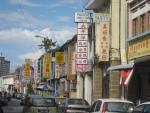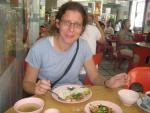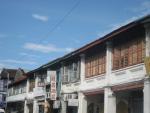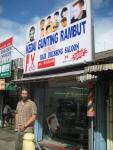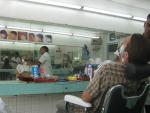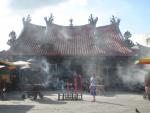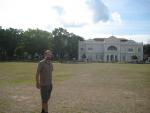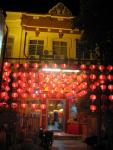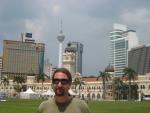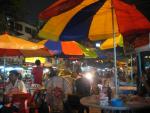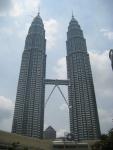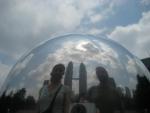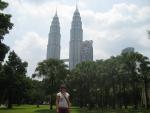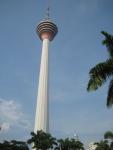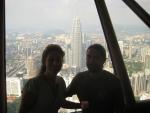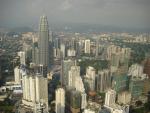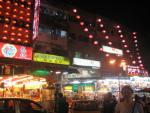Swapping beaches for skyscrapers
Sat 27th Mar 2010 — drew
Our final island hop and ferry journey took us from Langkawi to Georgetown, on Penang Island. Formerly known as Betel Nut Island, Penang was the first settlement of the East India Company on the Malay Peninsula in 1786 and it became an important port attracting settlers from all over Asia, predominantly China and India. The old town area is now protected as a UNESCO heritage site, recognised for the unique blend of cultures, religions and architectures.
Now, Georgetown has a population of over 1 million people and the skyscrapers spread along the coast marked a transition in our travels from beaches to cities. We found a grand old hostel in the heart of the old town where we based ourselves for a couple of days and the charming streets and lanes all around meant we didn't miss the beach for a second. It was intriguing to wander around the area and witness the marked change in influence from Chinatown to Little India with mosques, Hindu and Chinese temples all interspersed amongst the crumbling colonial architecture. We visited the interesting museum which explained the history of the island and cultures. Unfortunately, we found out that the furnicular railway up Penang hill, an old colonial hill station was shut so we didn't make it up there but with such a short time on the island we had plenty to keep us occupied.
Penang is also renowned as being the culinary capital of Malaysia, especially noted for its hawker stalls selling a huge variety of fusion foods. It was quite frustrating to only have one stomach as the look and smells of food on every street made you tempted to have a little taste. We did our best to sample as much as we could, enjoying the best curry we have had since leaving India, some delicious Chinese chicken and Penang specials including Laksa which is thick noodles in a hot-sour fish broth with tamarind and mint (this was really very tasty and aromatic although the fish is generally mackerel and was at the limits of our fish-endurance scale). Drew also enjoyed a long-overdue visit to an Indian barber in Penang's Little India.
Although an island, there is a 13km bridge that connects Penang to the mainland, so after a very enjoyable stay we got a bus to Kuala Lumpur. We had heard on our travels that Malaysian buses are very spacious and comfortable but were still surprised when we got on to find big, wide seats with reclining backs and plenty leg room which made for a very easy, pleasant 6 hour journey to the capital. After a brief, sweaty search we found ourselves a hostel that we were happy with and began to explore. We had not read or heard a huge amount about KL beyond the Petronas Towers so it was interesting to discover what the city had to offer.
The city centre is quite compact, and linked by a mono-rail and sky-train system, so it is quite easy to get around; but it felt much hotter than we have been for a while and walking around in the heat quickly sapped our energy leading to frequent rest and rehydration stops.
Between leaving Bangkok and our stint of island hopping, the trend had generally been downwards in scale, probably reaching the lowest point on Lao Liang with its handful of tents; we're certainly now moving back up the spectrum, and Kuala Lumpur has an impressive array of skyscrapers. We mentioned before that Malaysians have a fondness for superlatives and KL has the Petronas Towers which we believe are still the tallest twin towers in the world and were the tallest buildings until Taipei 101 took the crown in 2004. The Petronas Towers are private office towers for the government-owned Petronas oil company and tourists are only able to ascend as high as the sky-bridge between the two towers about a third of the way up. There is however another giant on the skyline, the KL Tower (apparently the 4th highest telecom tower in the world) and very near the top is a viewing platform and revolving restaurant offering breath-taking views across the whole city. A ticket for tea in the revolving restaurant was only pennies more than a trip to the viewing platform on the floor below, so we opted for coffee and a cake and a very slow tour of the amazing views on offer. Every afternoon we were there KL experienced fierce thunderstorms in the afternoon, and we were glad to be safely down on terra firma again before the afternoon's storm arrived - witnessing the lightening and ground-shaking thunder from the top of the tower would certainly have been dramatic, but it was dramatic enough for us at street-level!
A couple of other record-breakers we witnessed in KL were the massive flag pole on the edge of the former colonial town square (the biggest in Asia, if we recall correctly), and the biggest shopping mall in South East Asia, which incorporates an indoor theme park (the biggest indoor theme park in SE Asia of course) complete with roller coaster, and was quite surreal. We found ourselves feeling more at home on one of the bustling streets filled with small street-cafes, where a mix of Thai, Indian, Chinese and Malay cuisine were on offer. The vendors were very well practised at putting big umbrellas up when the evening rains came, and we barely noticed it had started pouring down around us one night.
One week in Malaysia was not very long, but we really enjoyed it - the beaches and mountains in Langkawi were very pleasant, but it was the fascinating colonial history, and melting pot of cultures and their cuisines in Penang and Kuala Lumpur that really stood out for us. We could have happily stayed longer.
- ‹ previous
- 59 of 70
- next ›

